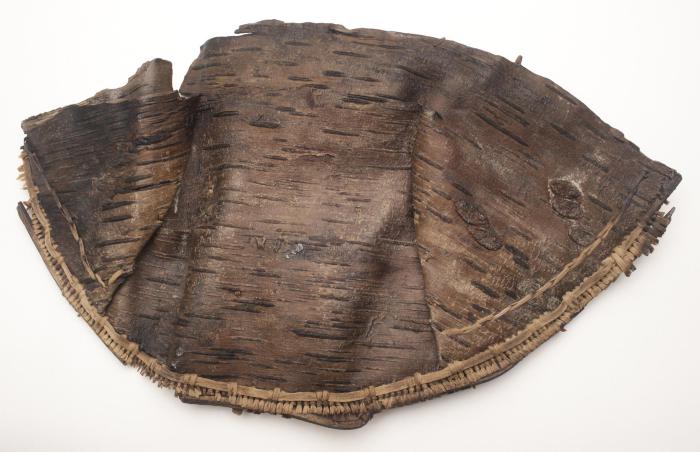Birch Bark — Qasrulek, Qasruq
Qantaq qasrulegmek canamauq. – The container is made of bark.

Photo: Container made of paper birch bark and spruce root. Karluk One site, Koniag, Inc. Collection. AM193.
Alaska Native people have been harvesting the bark of the paper birch (Betula neoalaskana Sarg.) for millennia. The tree’s sturdy, flexible, waterproof bark is an excellent material for manufacturing boats and containers and can be used as roofing. People typically collect birch bark in the spring, when it is easiest to remove from trees. Older birches produce good, flexible bark. Based on subtle clues in a tree’s appearance, experienced harvesters can identify those with the best bark. They also know which side of a tree to harvest from and are careful to strip off only the outer bark. If you damage the inner bark, you can kill the tree. To work with the material, craftsmen often heat or steam the bark to help it fold, and then use willow or spruce roots to stitch an object together.
Paper birch trees are rare in the Kodiak region, although the related, smaller Kenai Birch (Betula kenaica Evans) is common in coastal thickets. Today, a stand of paper birch grows in the river valley at the head of Midway Bay, just north of Old Harbor. Paper birch also arrives in the Kodiak Archipelago as driftwood.
Despite the limited quantities of paper birch available on Kodiak, archaeological finds suggest that Alutiiq people either made birch bark containers or traded with neighboring Athapaskan people for finished items. At a village site on the shore of Karluk Lagoon, researchers found fragments of birch bark vessels made by folding and sewing sheets of paper birch bark. One resembles an oval dish, another is rectangular and folder like a traditional Alutiiq sewing bag.
Paper birch trees are rare in the Kodiak region, although the related, smaller Kenai Birch (Betula kenaica Evans) is common in coastal thickets. Today, a stand of paper birch grows in the river valley at the head of Midway Bay, just north of Old Harbor. Paper birch also arrives in the Kodiak Archipelago as driftwood.
Despite the limited quantities of paper birch available on Kodiak, archaeological finds suggest that Alutiiq people either made birch bark containers or traded with neighboring Athapaskan people for finished items. At a village site on the shore of Karluk Lagoon, researchers found fragments of birch bark vessels made by folding and sewing sheets of paper birch bark. One resembles an oval dish, another is rectangular and folder like a traditional Alutiiq sewing bag.
